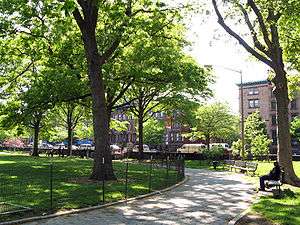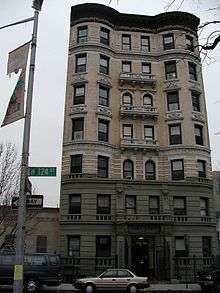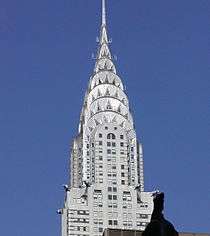Marcus Garvey Park

Coordinates: 40°48′16″N 73°56′37″W / 40.804487°N 73.943696°W
Marcus Garvey Park (formerly and also named Mount Morris Park) is located in Harlem in the New York City borough of Manhattan. The 20.17-acre (81,600 m2) park, centered on a massive and steep outcropping of schist and surrounded by flat lawns and playing fields, interrupts the flow of Fifth Avenue traffic,[1] which is routed around the park via Mount Morris Park West. The park is bounded by 120th Street and 124th Street and by Madison Avenue on its east side. The park is operated and maintained by the New York City Department of Parks and Recreation.
History
Before the arrival of Europeans, the rocky hill was used by Native Americans as a lookout station to see over the entire island. During the American Revolutionary War, Hessian soldiers "mounted a battery on [the hill]," "to command the mouth of the Harlem River." [2] When Fifth Avenue was extended north of Central Park as the railroads made Upper Manhattan more accessible, the rocky hill proved a difficult obstacle to clear; it was set aside for public use in 1836 and officially opened in 1840.[3] Music has been played in the park since its beginnings, with the Parks Department promoting performances in 1872 and 1893.[4] By 1900 a refreshment booth had been built at the 120th Street and Madison Avenue entrance to the park.[5] A long vehicular tunnel to send Fifth Avenue through the center of the rock was proposed by Manhattan Borough President Samuel Levy and approved by Robert Moses in 1936.[2] It was never built.
In the summer of 1969 the park was the site of the Harlem Cultural Festival, a series of concerts that came to be known as "Black Woodstock."
Etymology
Early Dutch settlers called the hill Slang Berg, or Snake Hill. This name was commonly used before the park was created. When the park was opened to the public in 1840, the park was possibly named for newly elected Mayor Robert Morris, although the origin of this name is not certain.[6]
In 1970, the Community Thing and other activist groups suggested naming the park for Marcus Garvey, a publisher, journalist, entrepreneur, activist for black nationalism, and founder of the Universal Negro Improvement Association and African Communities League (UNIA-ACL). They also asked that a portion of the newly built recreation center contain a Garvey Museum.[7] August of that year saw the African Nationalist Activist Movement calling for a Marcus Garvey Day celebration, with the New York Times noting that the park was already being "called Garvey Memorial Park by some persons."[8] More than 1,000 reportedly attended the celebration in the park.[9] City Council voted to officially rename the park to Marcus Garvey Memorial Park in 1973, during the same vote in which "Welfare Island" was renamed Roosevelt Island.[10] The portion of Fifth Avenue in Harlem was also proposed to be renamed Marcus Garvey Boulevard by advocates and the two surrounding Community Boards in 1988, but this effort ultimately failed amid complaints from residents who feared that the street would lose its reputation and lead to confusion.[11]
Features

Watchtower
The Harlem Fire Watchtower was designed by Julius H. Kroehl and erected in 1855–57 of cast iron. The tower was fitted with a 10,000 pound bell cast by Jones & Hitchcock. The watchtower allowed observers to use the natural elevation of the park and the added height of the structure to search for fires, in an era when most buildings were made of wood. The 47-foot (14 m) cast-iron tower is the only one to survive of eleven that had been constructed in the city, and was designated as a landmark in 1967. The watchtower, still bearing its bell, is located at the center of the park on an artificial plateau called The Acropolis.
Facilities
Facilities in the park include the Pelham Fritz Recreation Center and the Richard Rogers Amphitheater (both located on the west side of the park at 122nd Street), and Swimming Pool (open in summer) on the north side of the park, and two playgrounds designed for infants and disabled children, which were built in 1993. A Little League baseball field occupies the southwest corner of the park. A dog run with wood chip footing is located on the southeast corner of the park.
Much of the rusticated stonework stairs and walling has been patched with concrete; capstones have been dislodged by vandals. Sections of the upper part are closed off with chainlink fencing.
Most of the park closes at 10 pm; the upper section closes earlier, at dusk.
See also
- List of New York City parks
- Charlie Parker Jazz Festival
- City Parks Foundation
- Mount Morris Park Historic District
References
- ↑ Centered on Fifth Avenue on the south perimeter of the park stand wrought iron gates bearing the medallion "MB".
- 1 2 "Snake Hill Tunnel Proposed by Levy". New York Times. January 21, 1936. Retrieved 2 May 2015.
- ↑ Peck, Richard (April 11, 1976). "Harlem: Valley of Myths". New York Times.
- ↑ "Music at Mount Morris Park." New York Times. May 30, 1893.
- ↑ "Beer Obtained in at Park." New York Times. August 9, 1900.
- ↑ "Marcus Garvey Park." Mount Morris Park Community Improvement Association. http://www.east-harlem.com/parks_mg.htm
- ↑ "An Arts Complex Opens in Harlem." New York Times. June 27, 1970.
- ↑ "Celebrations Start Today Honoring Marcus Garvey." New York Times. August 16, 1970.
- ↑ "1,000 in Harlem Park See Black Program." New York Times. August 17, 1970.
- ↑ "Welfare Island to Be Renamed Roosevelt." New York Times. July 18, 1973.
- ↑ "Metro Matters; Battle to Block The Re-naming Of Fifth Avenue." Roberts, Sam. New York Times. February 15, 1988.
